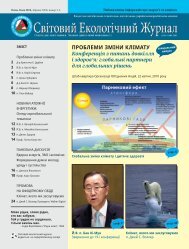V. XXII No 2, 3 - World Information Transfer
V. XXII No 2, 3 - World Information Transfer
V. XXII No 2, 3 - World Information Transfer
Create successful ePaper yourself
Turn your PDF publications into a flip-book with our unique Google optimized e-Paper software.
a Floods• Sea surface warming will cause rise in sea level withincreased flooding of coastal areas• 13/20 of world’s megacities are at sea-level• Large-scale population displacement possible with 1meter rise in sea level (18.6 million in China, 13 millionin Bangladesh)• Salination of fresh-water aquifers, disruption of stormwaterdrainage and sewage disposala Drought• 1.7 billion people live in water-stressed areas, expectedto increase to 5 billion by 2025• Reduced food production, increased wildfires, infectiousdiseases associated with poor hygieneClimate change,not just “global warming”a Hydrologic cycle altered as warmer air able to retainmore moisture• More rainfall in some areas, drought in others• More severe weather events- Between 1951 and 2000, 3.3% of earth’s surfacechanged from one climate category to anothera Less polar and boreal climates, more arid climatesClimate change and human healtha Thermal stressa Floods, droughts, extreme stormsa Worsening air pollutiona Infectious diseases• Water- and vectorborne diseasesWeather extremesa Thermal stress• Can lead to cardiovascular and respiratory failure• Heat waves in US more deadly than hurricanes, floods,and tornadoes combined• 2003 heat wave in Europe caused 22,000 deaths in 2weeks• Increased risk of death in urban areas (urban heat islands)and with poor housinga Severe storms• Death, disability, property loss (e.g., in 1998 HurricaneMitch resulted in >19,000 deaths, 2.7 millionhomeless, and $6 billion damages in Central America)• Sea surface warming of slightly over 2°C would intensifyhurricane wind speeds and may increase numberof hurricanes• Concentration of populations in coastal areas and environmentaldegradation increase vulnerability<strong>World</strong> <strong>Information</strong> <strong>Transfer</strong>8 <strong>World</strong> Ecology ReportSummer-Fall 2010Air pollutiona Ozone concentration may increase as a result ofwarmer temperatures• Asthmaa Pollen concentrations may also increasea Warmer air may disperse air pollution over largerareasClimate and infectious diseases:vectorborne diseasesa Higher diversity of insect vectors in the tropicsa Insect vectors more active at higher temperaturesa Anopheles mosquitoes require temperatures >16ºCto complete their life cycles• And Plasmodium sp develop more rapidly at temperatures>20ºC• One mosquito can infect 200 people with P. falciparuma Mosquitoes tend to thrive in aquatic habitats• Epidemics of malaria and dengue fever occur duringrainy seasons in the tropics, and interannually withweather events associated with El Nino-Southern Oscillationa But epidemics of West Nile virus occur duringdroughts• Mosquitoes and birds brought into close proximityat scarce water sources• Fewer natural predators of mosquitoes as wetlandsdry upClimate and infectious diseases:waterborne diseasesa Drought• Water scarcity leads to poor sanitation• Much of population can be exposed to potentiallycontaminated water• Example: recent cholera epidemic in Kenya- As of 12/5/09, 4,700 cases and 119 deaths




